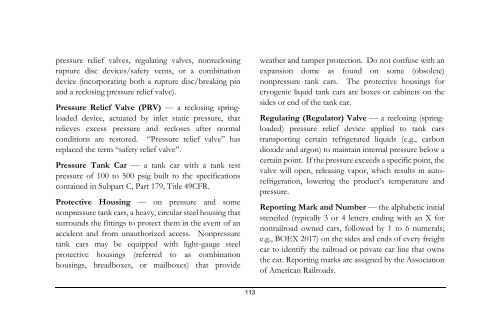Third Edition
2017%20Field%20Guide%20for%20Tank%20Cars
2017%20Field%20Guide%20for%20Tank%20Cars
You also want an ePaper? Increase the reach of your titles
YUMPU automatically turns print PDFs into web optimized ePapers that Google loves.
pressure relief valves, regulating valves, nonreclosing<br />
rupture disc devices/safety vents, or a combination<br />
device (incorporating both a rupture disc/breaking pin<br />
and a reclosing pressure relief valve).<br />
Pressure Relief Valve (PRV) — a reclosing springloaded<br />
device, actuated by inlet static pressure, that<br />
relieves excess pressure and recloses after normal<br />
conditions are restored. “Pressure relief valve” has<br />
replaced the term “safety relief valve”.<br />
Pressure Tank Car — a tank car with a tank test<br />
pressure of 100 to 500 psig built to the specifications<br />
contained in Subpart C, Part 179, Title 49CFR.<br />
Protective Housing — on pressure and some<br />
nonpressure tank cars, a heavy, circular steel housing that<br />
surrounds the fittings to protect them in the event of an<br />
accident and from unauthorized access. Nonpressure<br />
tank cars may be equipped with light-gauge steel<br />
protective housings (referred to as combination<br />
housings, breadboxes, or mailboxes) that provide<br />
weather and tamper protection. Do not confuse with an<br />
expansion dome as found on some (obsolete)<br />
nonpressure tank cars. The protective housings for<br />
cryogenic liquid tank cars are boxes or cabinets on the<br />
sides or end of the tank car.<br />
Regulating (Regulator) Valve — a reclosing (springloaded)<br />
pressure relief device applied to tank cars<br />
transporting certain refrigerated liquids (e.g., carbon<br />
dioxide and argon) to maintain internal pressure below a<br />
certain point. If the pressure exceeds a specific point, the<br />
valve will open, releasing vapor, which results in autorefrigeration,<br />
lowering the product’s temperature and<br />
pressure.<br />
Reporting Mark and Number — the alphabetic initial<br />
stenciled (typically 3 or 4 letters ending with an X for<br />
nonrailroad owned cars, followed by 1 to 6 numerals;<br />
e.g., BOEX 2017) on the sides and ends of every freight<br />
car to identify the railroad or private car line that owns<br />
the car. Reporting marks are assigned by the Association<br />
of American Railroads.<br />
113


